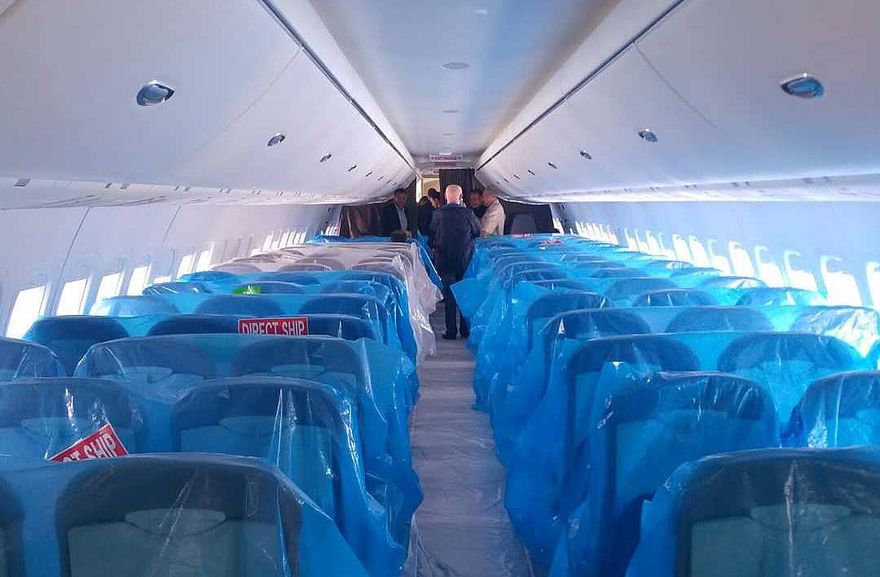Safran Urges Russia to Make Substitutes for U.S. Engine Parts
Safran is urging Moscow to create substitutes for U.S. vendor items in the PowerJet SaM146 and launch them into mass production in a hope to put an end to the monopoly of certain makers in the global market for complex parts in commercial turbojet engines. If the Russians commit, Safran promises to place big orders for similar parts in other engines so as to reduce their unit costs and increase production rates, according to top-ranking managers in the Russian aerospace industry who asked for anonymity.
Safran, for its part, confirmed it has drawn a "joint roadmap" with Rostec that lists priority parts and specifies certification requirements for new partners in Russia. "We are continuing to look at the possibility of further integrating Russian industry into our supply chain, not just in relation to the production of parts for the SaM146, but also for other programs such as the Leap and the CFM56," Safran wrote in response to emailed questions from AIN on the plans. "We hold Russian industry and its capabilities in very high regard, and we have no doubt that they are fully committed to meeting all of the necessary performance and certification criteria."
According to the Russian executives, talks on the matter began shortly after U.S. President Donald Trump’s decision to scrap the nuclear deal with Iran and exercise stricter control over high-tech exports to that country. Moscow and its key European partners on the Sukhoi Superjet 100 (SSJ100) entered consultations on how to remove the type from the scope of Washington’s trade restrictions in hopes of selling equipment to Iranian airlines.
The issue of parts for the SaM146 turned worse after in-service engines began developing more failures, the problem traced to lower-than-expected service life for certain elements in the hot section. PowerJet advised operators to send their engines to the manufacturer for inspection and repairs, but soon thereafter it appeared that the industry couldn’t do the work on short notice due to insufficient capacity of maintenance centers and a shortage of spares. Sukhoi Civil Aircraft (SCAC) and United Engine Corporation (Russian acronym ODK) formed a pool of replacement engines to keep SSJ100s flying, at the cost of slowing output of new airframes. The deficit of engines meant that up to 20 otherwise completed airframes remain grounded at the manufacturing plant in Komsomolsk-upon-Amur and SCAC's main base at the Ramenskoye Aerodrome.
Despite persistent efforts, PowerJet has so far failed to raise SaM146 production rates above 60 annually, chiefly because of a shortage of certain parts supplied by U.S. vendors. The list of those suppliers includes PCC Structurals, TECT, Chromalloy, Carpenter, Cannon Muskegon, and Hayes International.
Headquartered in Portland, Oregon, PCC Structurals specializes in superalloy, aluminum, and titanium investment casting. Its position in the global market strengthened following Warren Buffett’s purchase of Precision Castparts in 2015. According to industry insiders, PCC Structurals enjoys a monopoly in the market for complex parts made of titanium, as only it has mastered the needed advanced casting technologies. For years, the company has served as the sole supplier of the so-called intermediate bearing for the SaM146.
Although the Trump administration and U.S. Congress imposed numerous punitive measures on the Russian aerospace and defense industries, they do not cover the supply of U.S. parts for the SaM146, meaning the short supply issue stems from purely commercial considerations Citing high expenses needed to boost production, the manufacturer has agreed to do so only in the event of a large order with prepayment. The current production rate of the SaM146 remains relatively small, however, as does the production increase under consideration by PowerJet and SCAC. "There is currently supply chain stress for forging and casting parts' production, which impacts all the stakeholders in the aerospace industry given the complexity of the parts to be manufactured," confirmed Safran, who acknowledged that it holds regular discussions with SCAC and the Russian Ministry of Trade and Finance to assess their needs.
PowerJet and its patron Safran have asked Moscow to find a solution. Thanks to the huge expertise Russia has amassed in the manufacture of complex titanium products, certain enterprises within its military-industrial complex appear capable of handling such an assignment. But most of them remain busy with a state order for military equipment and will not make an effort on the SaM146 unless given the assignment by the Kremlin.
French negotiators have repeatedly asked their top-ranking Russian counterparts to issue the assignment and allocate the necessary funding to cover nonrecurring costs associated with technology and production preparation, according to the aerospace executives. If the Russian industry masters production of complex titanium parts for the SaM146 and demonstrates high quality, Safran promises to place large orders for similarly configured parts for those engines as well as CFM International models.
For its part, ODK has already tasked its member UMPO (Ufa Machinery-building Production Association) to produce substitutes for the SaM146 parts PowerJet now purchases from the U.S. But the executives who spoke with AIN doubt that UMPO possesses enough resources to handle the job.
Russia maintains a full-fledged scientific research establishment specializing in engine technologies in the form of CIAM, the Central Institute of Aviation Motors. Because of the complexity of the issue, finding a solution might require the involvement of certain other scientific establishments that historically specialize in naval equipment. They would need a clear directive from the Kremlin to get involved and share technologies they have created under classified military projects.
Starting in 1970, with the induction of the K-222 submarine of Project 661, nicknamed the Golden Fish for its huge development and manufacturing costs, the Russian navy has operated a number of submarines with hulls made of titanium, including a few highly secret vessels for deepwater operations whose development and manufacturing the defense ministry financed. For the respective technologies to become available to civilian programs, such as that of the SSJ100 and SaM146, their proprietors and developers need the Kremlin’s permission.
https://www.ainonline.com/aviation-news/air-transport/2019-07-22/safran-urges-russia-make-substitutes-us-engine-parts







